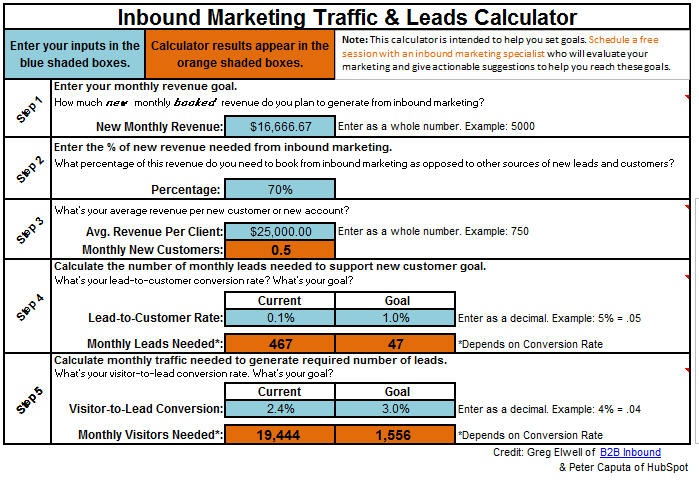 Many SMB business owners see how inbound marketing can help them grow their businesses. After all, they know that buyers use Google searches and social media recommendations in their buying processes. They do it themselves when they buy products and services. But the question any business owner will ask before making any investment is, "What return will I get?" Inbound marketing is a set of processes that help businesses get found by those who are looking for a solution that they offer, converts that person into a lead or sale, and then analyzes their behavior to learn how to attract more people who might be looking for their solution.
Many SMB business owners see how inbound marketing can help them grow their businesses. After all, they know that buyers use Google searches and social media recommendations in their buying processes. They do it themselves when they buy products and services. But the question any business owner will ask before making any investment is, "What return will I get?" Inbound marketing is a set of processes that help businesses get found by those who are looking for a solution that they offer, converts that person into a lead or sale, and then analyzes their behavior to learn how to attract more people who might be looking for their solution.
What Investment Do I Need To Make To Do Inbound Marketing?
Inbound Marketing Automation Software
When you invest in inbound marketing, you need to understand that it is a connected series of processes. If you're not doing all of the processes in an integrated manner, your return will be minimal. The glue that holds the process together is a full-featured marketing automation software platform like HubSpot. HubSpot has everything you need to do inbound marketing in an integtrated software package. HubSpot has pricing packages for SMB businesses that range from $2,400 per year to roughly $10,000 per year, depending on your requirements and the number of contacts in your current marketing database. There are other software packages available for SMB owners in a similar price range. This is the first investment I recommend to SMB companies starting an inbound marketing program.
Content Creation
Content like blog articles, eBooks and videos are the fuel that powers the inbound marketing process. Blog articles based on keyword phrases relevant to your business promoted on your social media channels attract vistors to your website. Leads are generated when potential buyers exchange their contact information for premium content offers like eBooks and videos.
SMB companies are now faced with a choice: do I have the time and talent available internally to create content or do I need to outsource content creation? If you decided to create content internally, consider re-purposing your proposals and marketing information into blogs, eBooks and whitepapers. If you outsource content creation, I would recommend budgeting $50-$75 per blog article and $750 to $2,000 to create an eBook or video.
In order to convert visitors to leads, you need to create calls-to-action and landing pages. Most marketing automation software like HubSpot gives you the tools you need to create CTAs and landing pages. You can either create these internally or outsource the task to an inbound marketing agency. The choice comes down to the typical outsourcing question: do I have the time and talent to create these internally or do I need to outsource the process?
Lead Nurturing and Email Marketing
Most visitors aren't ready to buy when they first come to your website. Marketing researcher Gleanster found that 90% of website visitors aren't ready to buy when they first come to your website. Inbound marketers nurture these leads with inbound marketing to help them progress through their buying process until they are sales ready leads. Again, the question here is whether to create and manage these processes internally or to outsource them. Your marketing automation software will provide the platform to execute these processes.
Outsource Your Inbound Marketing Program
Companies like mine offer outsourced inbound marketing to SMB companies that don't have the internal resources to effectively manage their programs. We offer pricing packages that range from $1,500/month to $7,500/month. The primary difference in pricing is the amount of content you want to use in your program.
How Do I Measure My Inbound Marketing Return?
Unlike traditional marketing methods like advertising and PR, you can measure every element of your inbound marketing process. Inbound marketers have no place to hide - SMB managers can track every element of the process.
What Should You Measure?
So what should you measure? That's an easy one - measure web visitors, leads and sales. These are the metrics that matter, particularly sales. You can tie each of these 3 elements back to your inbound marketing. For example, you might find that LinkedIn is the best social media network for your business in terms of producing visitors, leads and sales. To increase your return, you might decide to devote the resources you're applying to Twitter to LinkedIn. This concept applies to all elements of your marketing - you can see which landing pages and email marketing campaigns are producing results and which aren't. Your inbound marketing won't be perfect when you first start. Good inbound marketersanalyze every element of their programs and dial in their processes as a result of marketplace feedback.
Integrating Inbound Marketing With Your Sales Process Is Critical
Unless you have an e-commerce business, there will come a time in your sales process where the online interactions with your leads need to transition to real conversations with your sales team. Sales resulting from inbound marketing are maximized when there is great integration between your sales and marketing teams from the very start of the process. For example, if the inbound marketing team produces leads that never get called by the sales team, you won't sell anything. Conversely, if the marketing team is producing low-quality leads, they won't convert to sold business. The best inbound marketers coordinate with sales from the very beginning of the process.
ROI-Based Planning
Before starting an inbound marketing program, I highly recommend developing ROI-based goals for website visitors, leads and customers. Here is a screenshot of a planning worksheet we use to help set these goals:

When we work through this process with our customers, we answer 2 primary questions:
- How many website visitors and leads do we need to generate from the inbound marketing program to hit our revenue targets?
- Are these numbers realistic.
As you can see, we manage our inbound marketing programs to hit ROI-based goals.
Summary
Unlike traditional forms of marketing, the return on your inbound marketing program is easy to measure precisely. Marketing automation software is a critical component of an ROI-based inbound marketing program; it should be the first investment you make when you commit to going inbound. The amount you invest in your program largely depends on whether you have resources and talent internally to run your program or if you outsource program management. The results you derive will depend on the skill with which you manage the program and your ability to analyze data to dial in your program based on marketplace feedback.
If you haven't already taken the plunge, I highly recommend inbound marketing as a great way to create a lead generation channel based on modern buying practices. If you think ROI from the beginning, you will increase your chances for a successful implementation.








